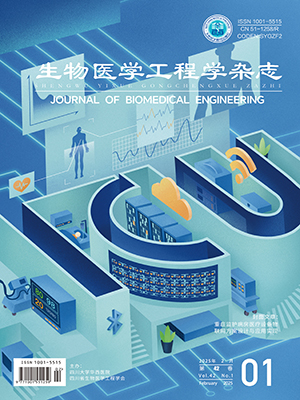| 1. |
岳献芳,王立.颅内压监测及微创应变电测新方法[M].北京:科学出版社,2008.
|
| 2. |
季忠.颅内压无创检测方法与实现[M].北京:高等教育出版社,2010.
|
| 3. |
刁丽,廖燕,陈弟洪.颅脑术后有创颅内压的监测及护理[J].护士进修杂志,2010,25(4):338-339.
|
| 4. |
周娜磊.眼压与颅内压,血压相关关系研究[D].石家庄:河北医科大学,2011.
|
| 5. |
曾高,焦风,梁冶矢.颅内压的无创与智能化监测[J].山东医药,2010,50(24):1,38.
|
| 6. |
JETZKI S,WEINZIERL M,KRAUSE I,et al.A multisensor implant for continuous monitoring of intracranial pressure dynamics[J].IEEE Trans Biomed Circ Syst,2012,6(4):356-365.
|
| 7. |
王立,岳献芳,董继昌,等.微创颅内压检测系统及其使用方法:中国专利,CN1813629[P].2006-08-09.
|
| 8. |
RABOEL P H,BARTEK J Jr,ANDRESEN M,et al.Intracranial pressure monitoring:invasive versus non-invasive methods-A review[J].Crit Care Res Pract,2012:950393.
|
| 9. |
季忠,彭承琳.颅内压无创检测分析方法及其实现[J].仪器仪表学报,2012,33(2):457-462.
|
| 10. |
LE B D,JOHANSEN-BERG H.Diffusion MRI at 25:exploring brain tissue structure and function[J].Neuroimage,2012,61(2):324-341.
|
| 11. |
周平,李传富,符志鹏.基于小波分解的脑CT图像纹理特征提取[J].仪器仪表学报,2010,31(3):643-648.
|
| 12. |
CHEN H,WANG J,MAO S Z,et al.A new method of intracranial pressure monitoring by EEG power spectrum analysis[J].Can J Neurol Sci,2012,39(4):483-487.
|
| 13. |
张欣,谢松云,张朋,等.基于PC-MRI的无创测量颅内压方法[J].中国医学影像技术,2010,26(7):1350-1353.
|
| 14. |
YORK D H,PULLIAM M W,ROSENFELD J G,et al.Relationship between visual evoked potentials and intracranial pressure[J].J Neurosurg,1981,55(6):909-916.
|
| 15. |
吴西,季忠.基于小波变换的闪光视觉诱发电位的有效提取及颅内压无创监测的实现[J].生物医学工程学杂志,2011,28(6):1089-1093.
|
| 16. |
叶珩,霍家聪,陈纯波,等.闪光视觉诱发电位无创颅内压监测可行性研究[J].广东医学,2011,32(14):1877-1879.
|
| 17. |
代垠,田小波,任光阳.闪光视觉诱发电位技术监测颅内压85例[J].中国药业,2010,19(5):55-56.
|
| 18. |
王凡,胡阳春,徐源,等.闪光视觉诱发电位无创颅内压监测技术应用于重型颅脑损伤的临床观察[J].第三军医大学学报,2012,34(18):1915-1916.
|
| 19. |
季忠,彭承琳,杨力.基于闪光视觉诱发电位的颅内压无创检测及其仪器实现[J].仪器仪表学报,2010,31(12):2809-2814.
|
| 20. |
季忠,秦树人,彭承琳.基于单通道FVEP提取的虚拟式颅内压无创检测仪器的实现[J].中国生物医学工程学报,2007,26(5):713-718.
|
| 21. |
CHEN B,MO D P,LI Z Y,et al.Relations between intracranial pressure and parameters of transcranial doppler ultrasonography on model of rabbit[J].中国现代医学杂志,2004,14(14):55-58.
|
| 22. |
安红伟,卢昌均,程岗.经颅多普勒与闪光视觉诱发电位预测颅内感染患者颅内压的临床应用价值[J].临床神经病学杂志,2012,25(3):177-180.
|
| 23. |
DAVIDS J D,BIRCH A A,MARCHBANKS R J.NON-invasive measurements of intracranial pressure:can coherent averaging show a tilt-dependent change in the measured spontaneous tympanic membrane displacement (STMD) signal in healthy volunteers?[J].J Neurol Neurosurg Psychiatry,2012,83(3):e1.
|
| 24. |
STETTIN E,PAULAT K,SCHULZ C,et al.Noninvasive intracranial pressure measurement using infrasonic emissions from the tympanic membrane[J].J Clin Monit Comput,2011,25(3):203-210.
|
| 25. |
SAMUEL M,BURGE D M,MARCHBANKS R J.Quantitative assessment of intracranial pressure by the tympanic membrane displacement audiometric technique in children with shunted hydrocephalus[J].Eur J Pediatr Surg,1998,8(4):200-207.
|
| 26. |
MEHDIZADEH M,MOSALLAEI M,ALIBAI E A,et al.Correlation between intraocular pressure (IOP) and intracranial pressure (ICP) in dog[J].J APPL ANIM RES,2010,38(1):61-64.
|
| 27. |
艾宏飞,王健,毛思中.眼内压测定用于无创颅内压监测的可行性研究[J].第三军医大学学报,2009,31(2):163-165.
|
| 28. |
BANAJI M,MALLET A,ELWELL C E,et al.A model of brain circulation and metabolism:NIRS signal changes during physiological challenges[J].PLoS Comput Biol,2008,4(11):e1000212.
|
| 29. |
SHAW M,PIPER I,CAMPBELL P,et al.Investigation of the relationship between transcranial impedance and intracranial pressure[J].Acta Neurochir Suppl,2012,114:61-65.
|
| 30. |
COX-REIJVEN P L,VAN KREEL B,SOETERS P B.Bio-electrical impedance spectroscopy:alternatives for the conventional hand-to-foot measurements[J].Clin Nutr,2002,21(2):127-133.
|
| 31. |
KANAI H,HAENO M,SAKAMOTO K.Electrical measurement of fluid distribution in legs and arms[J].Med Prog Technol,1987,12(3-4):159-170.
|
| 32. |
林宁,潘搏,王洁,等.生物电阻抗技术临床应用现状及探讨[J].肠外与肠内营养,2010,17(2):122-124.
|
| 33. |
程星星.基于生物电阻抗方法的颅内压无创检测仪器系统的原理与实现[D].重庆:重庆大学,2010.
|
| 34. |
赵德春,任超世,沙洪,等.EIT高精度数字解调方法误差分析[J].仪器仪表学报,2010,31(9):1933-1938.
|
| 35. |
PETKUS V,RAGAUSKAS A,JURKONIS R.Investigation of intracranial media ultrasonic monitoring model[J].Ultrasonics,2002,40(1-8):829-833.
|




